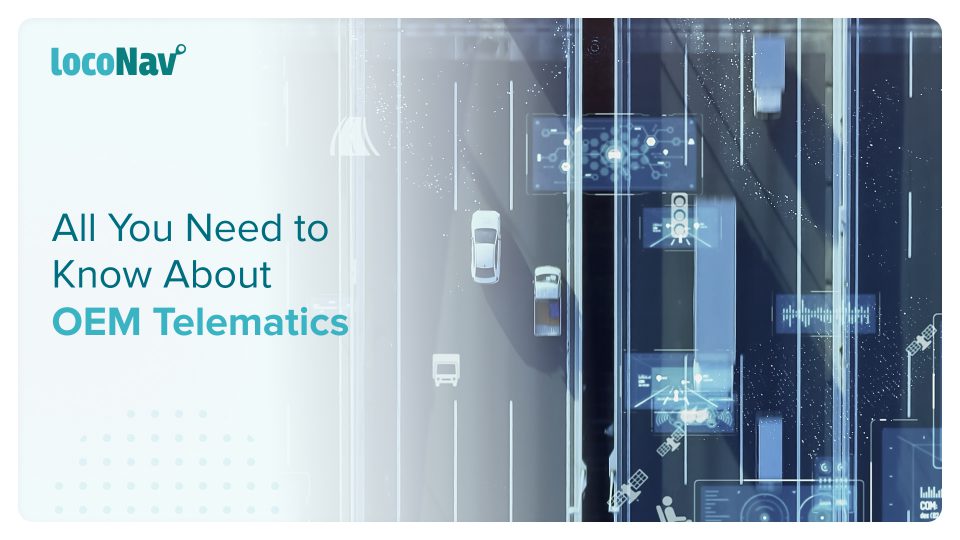

For fleet companies operating in competitive marketplaces, even little time and money can make or break their performance. A vehicle monitoring device by itself will not suffice in this situation. However, integrated fleet management technologies and OEM telematics solutions provide novel approaches to making your fleet more productive – and profitable.
Telematics software is quickly becoming a recommended practice in fleet management due to its established benefits for security, fuel efficiency, and vehicle maintenance. There is no longer any question regarding whether or not fleets should employ telematics data.
Now that we know why OEM telematics is required, let’s deep dive into what OEM telematics is, how it works, its advantages and challenges, and finally why you should choose to use it.
What is OEM Telematics?
In simple words, OEM Telematics is telematics technology embedded in the vehicle by the manufacturer of the vehicle.
Due to its demonstrated advantages and return on investment, it is more critical than ever to make telematics technology broadly and simply accessible to fleet-owning clients. As a result, most major automotive original equipment manufacturers (OEMs) already provide vehicles with factory-embedded telematics hardware that can be integrated with an aftermarket software provider intended expressly for fleet management analytics and business insights.
Original equipment manufacturer (OEM) telematics is divided into two categories:
- The hardware — OEM-installed automotive telematics hardware.
- The software – A cloud platform that collects and manages data from embedded telematics gear.
How does OEM Telematics work?
In the basic sense, a telematics system consists of a GPS tracking device integrated into a vehicle that allows the sending, receiving, and saving of telematics data. It links to a SIM card via the vehicle’s onboard diagnostics (ODBII) or CAN-BUS connector, and an inbuilt modem allows OEM telematics integration.
The gadget captures GPS data as well as a variety of other vehicle-specific data and transmits it to a centralized server through GPRS (General Packet Radio Service), 4G mobile data, cellular network, or satellite connection. The server analyses the data and displays it to end-users through internet sites and apps tailored for mobile phones and tablets.
Position, idling time, excessive speeding or braking, fuel usage, vehicle issues, and other information can be gathered via telematics. When evaluated for specific events and patterns, this data can provide detailed insights across a whole fleet.
What are the Advantages of Using OEM Telematics?
Telematics has advantages other than insurance company benefits. Here are some key advantages of purchasing a fleet vehicle with OEM embedded telematics:
- Unmatched Data Accuracy
OEM telematics data systems provide a high level of data quality and monitoring of vehicle health issues during vehicle operation because the sensors and functions are incorporated directly into the vehicle. This gives an appealing option for end-users who do not want to install additional gear. It also gives you access to information that isn’t necessarily available in aftermarket options, such as true odometer readings.
- More Scope for Value Added Services
Insurance companies will be able to offer additional intelligence and advice to drivers by connecting to ADAS connections within vehicles that are so fitted, opening up new prospects for innovative, value-added services.
- Allows Multiple Driver Communication
Smartphone connectivity can be used with in-vehicle communication equipment such as the driver console and interfaces that provide voice alerts or failure warnings, increasing driver involvement and allowing for richer communication.
What are the Challenges of OEM Embedded Telematics?
Using an OEM solution may appear to be easier on the surface. However, there are significant issues involved with OEM telematics that could make OEM systems appropriate for some fleets but not others. Continue reading to learn more about these challenges:
- Not Ideal for Mixed Fleets
If you have a mixed fleet with various makes, models, and years, you will have to use multiple OEM systems to track your entire fleet. With an OEM approach, you may have to replace every car and asset, which can be expensive.
- Cookie Cutter Approach
OEM solutions often provide a one-size-fits-all offering that cannot be adjusted to your individual requirements. This is problematic since your company faces varied obstacles depending on its business model, sector, fleet size, and other factors. To overcome these obstacles, you will want a telematics solution that can be adapted to your specific use cases.
- Data Security Issues
The timescale for OEM data gathering systems is unknown, and many issues remain concerning the actual data prices once this strategy evolves. Uncertainty exists in the domains of privacy and data ownership.
Why choose OEM embedded telematics?
With the increased availability of OEMs offering built-in telematics technology, you may be wondering if this is a viable choice for your fleet. After reading the following benefits, you may be more tempted to adopt OEM telematics:
- A fleet management solution that requires no additional device or hardware installation.
- The ability to deploy and use fleet management services immediately.
- Access to OEM private data, such as tire pressure and diagnostic codes, is critical for improving vehicle diagnostics and maintenance plans.
- Reduced logistical difficulties and vehicle downtime, which is closely correlated with aftermarket telematics installation.
- Reduced driver tampering, which frequently leads to erroneous reporting.
The decision between an OEM solution and an after-market telematics solution is significant. It is critical to examine your long-term goals for fleet operations. Would you like a telematics solution that can help you save money, minimize risk, and improve income while also increasing productivity and efficiency? If you answered yes, a sophisticated telematics solution is a way to go. If not, and you merely want to track the whereabouts of your brand-new vehicle, OEM is an option to explore.